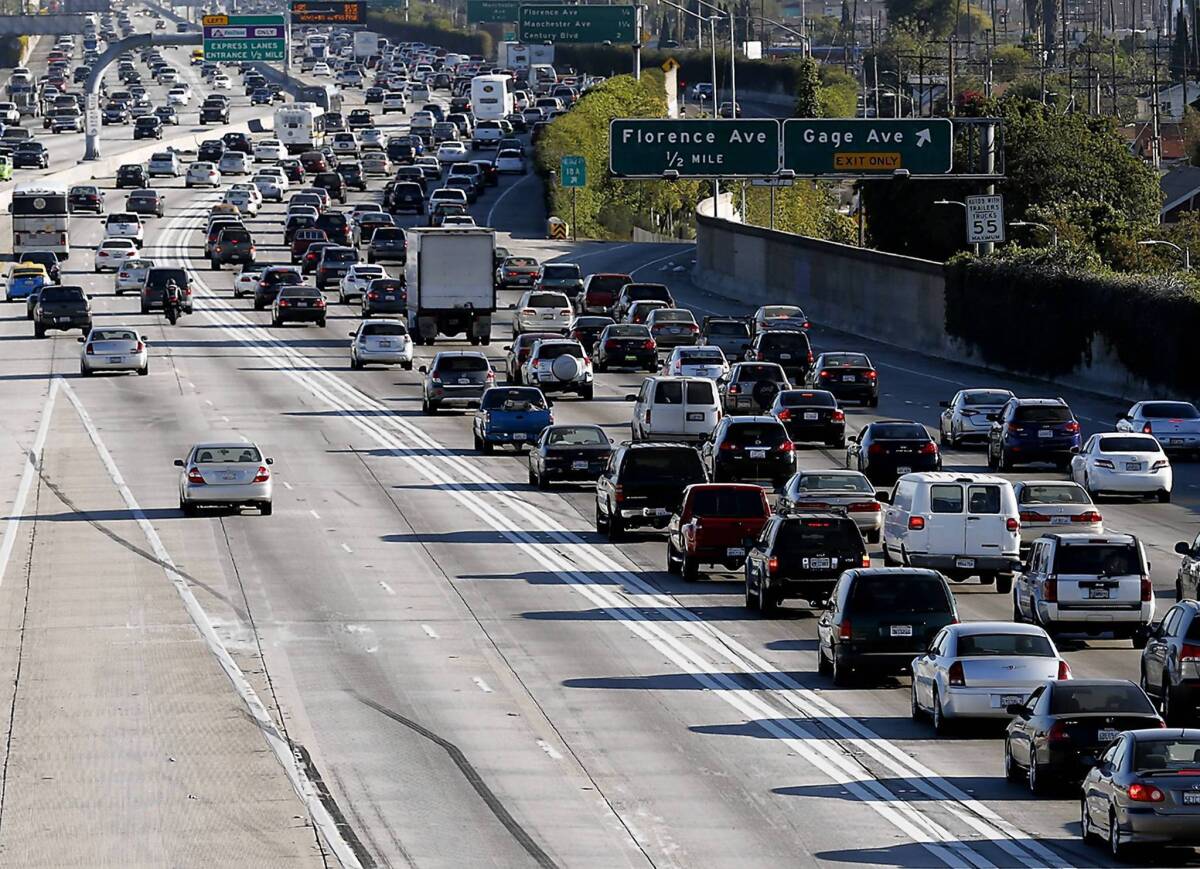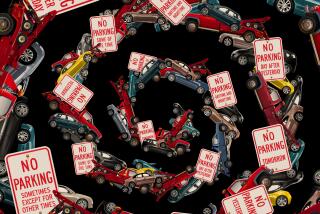Traffic zips in toll lanes, but slows in free lanes

When Los Angeles Countyâs inaugural toll lanes opened on the 110 Freeway late last year, Scott Sternad decided he could do without.
âNearly $1,000 a year?â said the 24-year-old engineering student, who commutes from Hermosa Beach to USC three times a week. âThatâs a lot of dinners and drinks.â
But remaining in the free lanes has cost Sternad time. His commute now takes 15 minutes longer than it did before the carpool lanes were reconfigured, he says.
Thatâs not what was supposed to happen. But the 110 remains something of a laboratory, and officials are hoping the toll lanes ultimately will relieve congestion on the entire freeway. The results from the experiment are expected to strongly influence decisions on possible expansion of toll lanes countywide.
Preliminary data backs up Sternadâs experience: Average travel speeds have increased in the lanes formerly reserved for carpoolers, but traffic has slowed on the rest of the freeway.
So for solo drivers paying up to $15.40 per trip, the new toll lanes are providing a faster commute. More than 135,000 motorists have purchased FasTrak transponders since the toll lanes opened. Officials have collected more than $3 million in tolls along an 11-mile stretch of the Harbor Freeway, south of downtown.
Operating and maintaining the lanes cost $2.9 million in the first three months. Any profits from the operation will be reinvested in transportation improvements along the Harbor Freeway corridor, officials said.
Traffic on the 110 toll lanes flowed at least 45 mph during peak hours, and 10 mph faster in the morning northbound rush than before the project, according to data covering the period from December to February. But non-toll lanes in the most congested segment â near Gage Avenue â slowed by more than 8 mph, to 29.6 mph, during the morning peak period.
Metropolitan Transportation Authority officials say thatâs because solo drivers are no longer illegally using the carpool lane, and other drivers are still deciding whether to buy a transponder. Some delays could be caused by drivers braking to read toll signs, they said.
About 7% of drivers who entered the toll lane during the study period did so incorrectly. After a brief grace period, the California Highway Patrol issued 412 verbal warnings and 307 tickets.
Traffic in the carpool lane initially decreased by about 10,000 trips a day or about 20%. Separate data from the California Department of Transportation, which is partnering with Metro on the project, showed that traffic volume declined by half in some segments of the toll lanes. But those numbers are gradually recovering, according to Metroâs data.
Many of those drivers presumably moved into free lanes, a Metro spokesman said, contributing to the traffic slowdown there.
Kathleen McCune, Metroâs toll lane director, stressed that the data are preliminary and drivers are still adjusting to the new system.
Some commuters may have avoided the freeway all together, said Clifford Winston, a government performance analyst at the Brookings Institute. Until â and unless â more drivers buy transponders, he said, extra traffic will be crowded into the no-cost lanes.
âGrowing pains. Itâs not surprising,â said Winston, noting that similar projects in Washington, D.C., and elsewhere saw the same pattern during the early months.
USC professor James E. Moore II said that if more drivers donât start using the toll lanes, the fee may have to be reduced.
âI donât sweat much that the lanes are being underutilized at first,â he said. âPrices can always be changed.â
In all, Los Angeles County has 453 miles of carpool lanes, and 53 more miles are under construction, according to Caltrans. If the current experiment succeeds, every carpool lane in the county could add tolls within 20 years, predicted Robert Poole, a Reason Foundation policy director and toll lane advocate.
âThe truth of the matter is, there arenât that many options leftâ to increase freeway capacity, Poole said.
A second phase of testing has begun on the 10 Freeway, where a 14-mile toll lane from downtown to the 605 Freeway near El Monte opened in February. Officials also have held a public hearing on proposed toll lanes for the 5 Freeway near Santa Clarita.
The 110 and 10 toll lanes are L.A. Countyâs first attempt at âcongestion pricing,â or charging solo drivers varying prices to use carpool lanes. The fees increase as regular traffic lanes become clogged. Toll lanes can shave two to three minutes a mile off rush-hour trips, officials say, and are seen as a way to maximize the efficiency of a largely built-out freeway network.
Prices range from 25 cents per mile during the least congested times to $1.40 per mile during the heaviest congestion. Carpoolers donât pay tolls, but must buy transponders.
In 1995, Orange County pioneered such âcongestion pricingâ in the United States on the 91 Freeway. Today, due to crowding, Caltrans is considering requiring carpoolers to have three people per vehicle to use those lanes for free.
Toll lanes are spreading across the country. Nine states have a total of 18 toll corridors. Twelve more are under construction. Some experts say the lanes are reducing gridlock in some of the nationâs most congested metropolitan areas, including Atlanta, Houston and Miami. Others analysts argue that the traffic benefits are overstated.
The L.A. toll lanes will be formally evaluated later this year. If certain benchmarks arenât achieved, including keeping toll lanes moving at 45 mph during rush hour, Metro will have to return $210 million in federal funding.
Critics say the effort creates âLexus lanesâ for the well-to-do. But low-income drivers have options to reduce costs, Metro officials say, including a $25, one-time credit that is being offered to low-income families.
Others, particularly carpoolers, have complained about a $3 monthly fee charged for the transponder â after the $40 purchase price â if the toll lanes are not used at least four times per month.
But much of the debate involves the tolls being charged. Ted Bischak drives a Honda Civic that runs on natural gas.
âI bought this car specifically so I could drive in the carpool lane,â said the 50-year-old Costa Mesa resident. âNow, I feel like Iâm paying twice.â
Bischakâs round-trip commute to a downtown real estate office costs about $8 a day in tolls. Heâs considering taking a different route to avoid the fees, even if itâs a little longer. âItâs the principle of the thing,â he said.
But others, including accountant Jennifer Lee, are sold.
âOh, itâs worth it. No question,â said Lee, 36. Since she âcavedâ and bought a transponder a month ago, she said sheâs trimmed her commute time from Irvine to downtown roughly in half.
Poole, whose think tank promotes libertarian principles and free markets, said commuters such as Lee should have that choice.
âThe idea that everyone has to be equally miserable all the time doesnât strike me as a good option,â he said.
More to Read
Sign up for Essential California
The most important California stories and recommendations in your inbox every morning.
You may occasionally receive promotional content from the Los Angeles Times.











